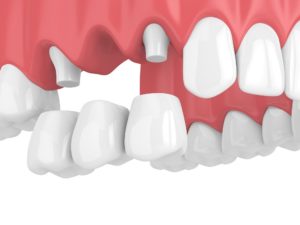If you have missing teeth, you likely have noticed a decline in your ability to perform oral functions and in the appearance of your smile. To enhance your oral health and prevent further deterioration of your smile, your dentist will recommend tooth replacement treatments.
Patients who have lost three or more teeth in a row can benefit from a dental bridge. This set of prosthetic teeth is an effective oral appliance, but there are two primary types to choose from.
Ask your dentist about bridges that you can take out of your mouth as needed and those that will always stay securely in the mouth. Read on to learn more about fixed and removable dental bridges and how each appliance can restore your smile after tooth loss.

Removable Dental Bridges
Dentists can offer you a removable dental bridge that you can wear throughout the day and take out of your mouth when not needed. However, you might feel more comfortable wearing this traditional dental bridge.
You can replace one or several teeth at once with this device. To ensure it stays secure, your dentist will prepare the adjacent teeth, which dentists call abutment teeth, on either side of the missing ones. They will shave a minute amount of enamel from these teeth. This way, the bridge can fit over them and snap into place.
These remaining teeth act as supports for the bridge prosthetic, keeping the appliance in place as you eat and speak as you normally would. Many patients appreciate this treatment because it provides an affordable tooth replacement option while still giving effective restorative benefits. You can feel confident in the look and feel of your smile again with this treatment.
Implant-Supported Fixed Dental Bridges
For optimal restorative advantages, dentists will recommend replacing missing teeth with an implant-supported dental bridge. This device uses two surgically placed titanium post anchors – one for each end of the bridge prosthetic. These go in the jaw and fuse to the bone there for maximum support. This healing process may take several months.
Once you recover, you will return to the dentist to receive your dental bridge. The dentist attaches the bridge to abutments above the gumline that secure to the two anchors. Because of the fusion to the jaw, the bridge can last for twenty or more years. This is a longer period than the traditional bridge can provide.
This treatment will take a great deal of time and cost more than a removable dental bridge. But it offers more benefits, which appeal to many dental patients. A traditional bridge that treats tooth loss only above the gumline. But the anchors of the dental implant replace missing tooth roots too. This can preserve the jawbone which may deteriorate after tooth loss.
Schedule a consultation with your dentist to discuss your budget, your desired results, and your medical history. Based on these factors, you and your dentist can determine whether a fixed or removable dental bridge can best restore your oral health in the wake of tooth loss.
